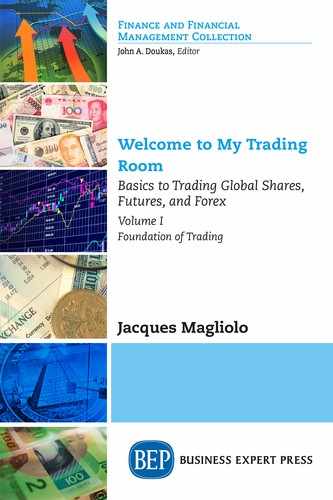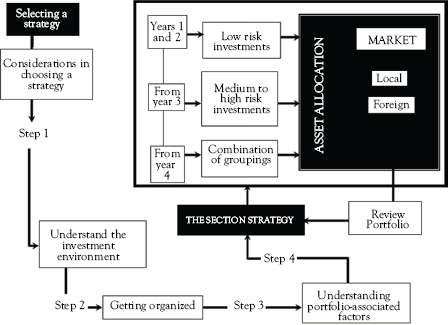Steps to the Ultimate Portfolio
The true art of stupidity is to sell trades that show a profit and keep those that show a loss.
There are effectively as many steps as there are different types of risks. I suggest the following diagram as an example of the time span that it takes the investor to understand the various elements that make up a sound portfolio. Therefore, once the investor has a sound knowledge of the following, he or she is ready to start trading:
• A sound understanding of the investment environment.
• Understands the mechanics of buying and selling shares.
• Has a firm grasp of portfolio-related risk factors, asset allocation, and methodologies.
I suggest a threefold approach to the creation of an investment portfolio.
• Start small, with low-risk investments for a period of at least 2 years. This will give the investor or trader time to get to understand how markets operate, factors that drive shares, and get that gut feel that makes the investor more street wise.
• Move into medium-risk investments. Here, I suggest indexing.
• After a period of 3 to 5 years, the investor can start combining shares with other investment alternatives.
Your Starting Point
The unit trust industry is a sound way to build up a relatively liquid portfolio, which can be cashed in after 2 years to start the share selection. In addition, this industry has been very successful in getting their message across. Traditionally, investors have thought of diversification, low cost, and access to strong management as the chief advantages of unit trusts.
The first two are true: Where else can an investor buy a portfolio containing hundreds of individual issues across a market with as little as $1,000? In addition, the fee structure is moderate and not crippling. The small investor thus has a chance to set up a portfolio and accumulate wealth.
However, if the investor does not believe that unit trust managers can add value, they can invest in index or passively managed funds. As designers of a superior investment strategy based on strategic global asset allocation, investors should select unit trusts that allow them to very tightly control their portfolio.
Unit trusts are gaining market share, because they are a better investment medium for the small investor to start a portfolio. However, it must be stressed that “start” is the operative word. Once investors have enough funds to move directly into the market, they should do so.
How does the unit trust industry work? Once understood, the investor can develop a few simple criteria to drive their selection decisions. This procedure is fairly straightforward and it allows you to gain control of the total investment process.
Unit Trusts
• General equity funds that invest in a wide range of shares. This is the perfect starting point for an investment strategy as they are established, have a lower risk, and provide a broad-based knowledge of stock market movements.
• Index funds can be used as the second step in the strategy, that is, before moving to index stocks, use index unit trusts to build knowledge of the index stocks. These unit trusts strive to track the performance of a targeted index.
• Specialist equity funds, which concentrate on specific types of shares, that is, mining, gold, financial, and industrial funds.
• Specific funds which invest in various specified market sectors. The investor can build up knowledge of sectors before moving into the stock market.
• Smaller company funds that can be used to boost the percentage growth of the portfolio.
• Income funds are invested in interest-bearing securities such as gilts.
• Managed funds, which offer a mix of the aforementioned types of funds, that is, equities, fixed-interest assets, and property.
It does not have to be perfect to be great. Get started. Do not wait for it to be perfect. It never will be and you will still be waiting when you are old and broke. The important thing is to get started on a sensible plan and exercise the discipline to carry it out. Start small and build over time. If the choices are not perfect, do the best you can.
Once the investor has become familiar with share movements (using unit trusts), the next step in performance monitoring is to build an asset allocation plan portfolio using only index stocks.
This is the start of building a real understanding of how shares work. It will help the investor understand the total performance of a portfolio and put it in perspective. There is, however, no difference in the mechanics of running an index stock portfolio to a unit trust portfolio.
During any form of portfolio review, the investor should strenuously resist the temptation to replace a disappointing fund with the latest fashion shares. Continually changing a portfolio is unlikely to improve performance and will result in a losing strategy. It is crucial to understand that fund evaluation and performance monitoring are tactical in nature.
An asset allocation plan should be changed only on the following basis:
• New, better analytical methods become known: When a new fundamental method of assessing shares and portfolios is promoted in the media, among analysts, and by the academia, distinguish between proven, tested, academic, industry research and complete nonsense.
• Moving into the global arena: When the investor moves from a domestic bound portfolio to a global one, it becomes important to understand and distinguish between:
![]() First-world market, where the company invested in is bound to that specific country, that is, Company AA is listed on the London Stock Exchange and operates only in the UK.
First-world market, where the company invested in is bound to that specific country, that is, Company AA is listed on the London Stock Exchange and operates only in the UK.
![]() First-world market, where the company invested in is listed in that country, but has operations in other markets, that is, Company AA is listed on the New York Stock Exchange and has operation divisions in other first-world or emerging markets.
First-world market, where the company invested in is listed in that country, but has operations in other markets, that is, Company AA is listed on the New York Stock Exchange and has operation divisions in other first-world or emerging markets.
Indexing
Indexing simply describes an investment approach that seeks to parallel the investment returns of a specified stock market benchmark, or index. The investment manager attempts to replicate the investment results of the target index by holding all—or in the case of very large indexes, a representative sample—of the securities in the index. There is no attempt to narrow industry sectors in an attempt to outpace the index, which means that indexing is really a passive approach emphasizing broad diversification and low portfolio trading activity.
Indexing, in its simplest form, thus means buying all of the stocks (or index stocks) of a specific sector, instead of trying to pick winners and losers.
Indexing is also called “passive investing” or “asset class” investing.
Benefits
Indexing eliminates the risks, costs, and uncertainties that are associated with actively managing a portfolio, that is, picking specific shares and picking these at the right time (market timing).
Cost Advantages
Investors should note that indexing is really not suited to investors who have a long-term strategy to achieve realistic returns, but higher than sector or overall market averages. If markets do operate efficiently, then it is impossible for all investors in the aggregate to outperform the overall stock market.
Comment
• Decide on a mix of active and passive techniques, that is, your aim should be 70 percent unit trust, 20 percent equities, and 10 percent cash initially.
• Once the investor has grown in confidence, develop a long-term strategy and reduce the unit trust component to around 10 percent.
• Define the market as tightly as possible, that is, large, small, foreign, emerging markets, Asia, Japan, Europe, and so on.
• Make sure the manager stays fully invested and within the assigned market.
• Define the style of companies to invest in, that is, growth versus value. (A strong value tilt should enhance performance and reduce risk.)
• Check expense ratio. (The lower, the better. Remember that, however, some markets cost more than others.)
• Check portfolio turnover. (The lower the better.)
• Compare performance to appropriate benchmark and competitive funds. Try to understand any variation from benchmark. (There is always a reason. Higher returns mean higher risk.)
Rebalancing the Portfolio
Once an investor has developed a long-term investment strategy, it is crucial to conduct periodic rebalancing, which means bringing the asset allocation back to its original target.
To bring your portfolio back to its original, predetermined mix:
• Sell the investment that exceeds its recommended percentage and invest the proceeds in other investments.
• Add new money to the investments that are below their recommended percentage.
• In a mutual fund setting, direct dividends from the investment that exceeds its recommended percentage to the investments that are below its target allocation.
The reason that it is necessary to rebalance a portfolio is to maintain a steady allocation between the different share selections. Rebalancing should be undertaken at least once a year, although some dedicated investors adjust their portfolios monthly or quarterly.
Adjusting Financial Plans
A long-term strategy does not imply a passive approach. Changes in life do occur and a plan to fine tune the portfolio is thus necessary. The following are examples of instances when an investor may consider changing his investment portfolio.
• Changing careers: Changing jobs, incomes, retirement, or an inheritance may change the focus of a long-term portfolio. The investor may want to be less conservative and more moderate or aggressive.
• An income change: A change in household income may lead to an adjustment in the amount earmarked for investment.
• A family change: A marriage, divorce, birth, or death could also have profound, yet quite different, effects on your investment planning, and may necessitate a review of your investment strategy.
• A change in monthly expenditure: Paying off a major expense may enable an investor to reexamine his financial status. The higher disposable income may permit the investor to start (or increase) a rand-cost averaging program.
• A change in age: The closer to retirement an investor gets, the more important it is to reassess the portfolio on a regular basis.
Once the investor has a sound knowledge of stock markets, investment criteria and methods of asset allocation, reducing risk profiles, and establishing a portfolio, it is time to develop a stock-picking strategy. What companies should you invest in? Where do you get information? How are companies evaluated?
In volume 2, we set out the basics of establishing your own trading room.

